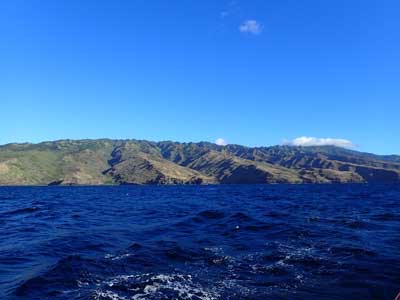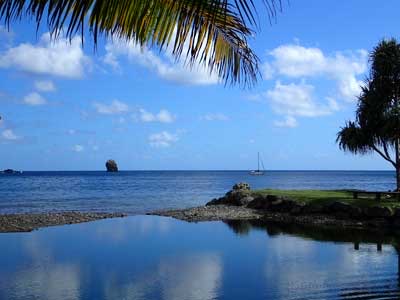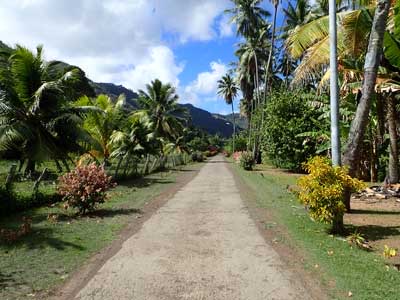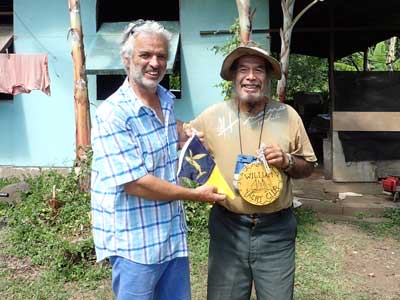The William Yacht Club

9:42.9S 139:00.9W The north coast of Hiva Oa looked interesting (Atuona, our first port of call, is on the south coast). There are a few well located anchorages and a large archeological site with some fine tikis on the north-east corner. Fewer yachts stop here than in Atuona (the main village) and it would make a good jumping off point for our overnight passage to Oa Pou, our next island, in the northern group.
The north coast of Hiva Oa In a book-swap somewhere along the way, we’d picked up an old copy of the ‘Moon Travel Guide to Tahiti’ It mentioned a man named William in Hanaiapa Bay ‘who welcomes yachties who come to sign his visitors book’. The forecast, for winds to go more northerly, made us give up any hopes of getting to the archeological site at Puamau, the anchorage would be too uncomfortable. Instead, we sailed straight to Hanaiapa Bay. From Tahuata, as soon as we rounded the western end of Hiva Oa, it was all to windward which made for a tough day’s sail. We pledged we wouldn’t do any more upwind passages in the Pacific, there simply is no need, if we miss an island, we’ll just stop off at the next one. We dropped anchor in Hanaiapa just before sunset, we were the only boat.
Caramor in Hanaiapa Bay The next morning we set off in search of William, allegedly he had a sign outside his house which said ‘Yacht Club’, and the petroglyphs which, according to Lonely Planet, are “on a large boulder, two hundred metres off the main road, at the entrance to the village”. The village was very pretty and well kept with flowers planted along the roadside, and signs saying “please keep our village and beach clean”.
Hanaiapa Village main road A young man and his grandmother were sat next to their house, a simple structure open on one side. There is no need for doors or windows here, it is always hot. They gave us directions to William’s house. Sure enough, there was the sign ‘William Yacht Club’ but as we approached, a utilities van pulled into the drive, so we carried on up the main road to the petroglyphs. Even with ‘Patch’, our self-appointed guide dog, we failed to find them. We asked a couple of people for directions but their French was very rusty. One man told us to “take the track left after the ‘thing’ by the side of the road”. I failed to get him to be more precise as to the nature of the ‘thing’, and although there was a large water pipe just before a track and a large(ish) boulder at 200 metres, there were no petroglyphs. Of course the question always is ‘how large is a large boulder?’ When I went to Gibraltar, in my imagination, ‘The Rock’ was a 15 metre tall boulder at the top end of town. I had never seen any photos of Gibraltar. I was a little surprised when I looked out of the plane window ... William was home, he was making copra. When he saw us, he grinned broadly and invited us into his house. He spoke English, and not French, much to our surprise. He showed us his visitor books and while we were reading comments left by other sailors, started bringing out fruit for us; a large bunch of bananas, a grapefruit, star fruit (the first we had eaten), a bag of limes and a new fruit to us, green and spiky of an uneven shape, the size of a small pineapple. He served us pink juice and donuts. We’d brought him a Caramor visitor card and an Ocean Cruising Club burgee.
Franco presenting the OCC burgee to William People of all nationalities had signed William’s books but it seemed he himself had never been to sea. He reckoned he had been gathering signatures for the past 40 years or so. He told us about his family; he was one of ten and had had five children himself, and in total he now had 17 grandchildren. As I was writing our comment, I overheard William tell Franco that his mother was ‘over there’. I looked up, as I was expecting to see her walk out of the next door house. It was a large grave in the garden William had pointed at! The ship from Tahiti was due to dock in Atuona in a few days’ time and William was keen to get on with copra making. Before we left, he talked us through the procedure. It is the main economic activity in Hanaiapa, as in most of the villages we have been to. Windfall coconuts are gathered up (nobody climbs the tree anymore). They are opened with an axe, the seed is removed and discarded, pigs will eat it later. William handed us the seed to try, it tasted mildly sweet with a soft texture and was very filling. The hard white flesh is extracted from the husk with a machete and is set to dry on a purpose made rack for a few days. Copra fetches a price of 150 Polynesian francs (approx. US$1.50) per kilo delivered to the port in sacks of 30kg.
William splitting coconuts
Copra drying shed
|





